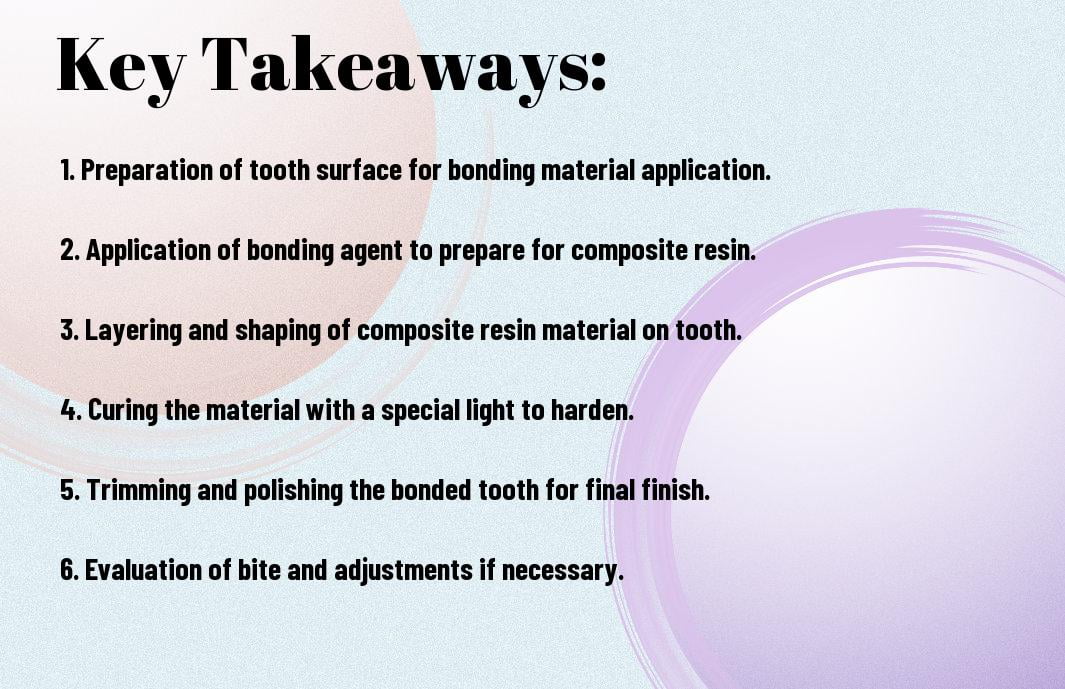Bonding is a common cosmetic dental procedure that can restore, repair, or enhance the appearance of teeth. Understanding the step-by-step process of dental bonding is crucial for anyone considering this treatment. The procedure involves etching the tooth surface, applying bonding agent, molding the resin material, and hardening it with a special light. By following these steps meticulously, dentists can fix chipped or discolored teeth, close gaps, or reshape teeth with minimal invasion. This informative guide will walk you through each stage of the dental bonding process, helping you make an informed decision about improving your smile.
Key Takeaways:
- Dental bonding is a simple and non-invasive procedure used to repair chipped, cracked, discolored, or misaligned teeth.
- The process involves roughening the tooth surface, applying a conditioning liquid, applying tooth-colored resin, shaping the resin, and then hardening it with a special light.
- Dental bonding is a cost-effective way to improve the appearance of your smile and can typically be completed in just one visit to the dentist.
Understanding Dental Bonding
Definition and Purpose of Dental Bonding
Definition: Dental bonding is a cosmetic dentistry procedure that involves the application of a tooth-colored resin material to repair teeth that are chipped, cracked, discolored, or misaligned. The purpose of dental bonding is to improve the appearance of the teeth and enhance the smile.
Types of Dental Bonding Materials
To understand the types of dental bonding materials used, it’s important to note that there are two main options: direct composite bonding and adhesive bonding. Direct composite bonding involves the use of a tooth-colored resin that is applied directly to the tooth and shaped to improve its appearance. Adhesive bonding, on the other hand, uses a dental adhesive to bond materials such as porcelain or ceramic to the tooth surface. The choice of material depends on the specific dental issue being addressed.
| Direct Composite Bonding | Adhesive Bonding |
|---|---|
| Uses tooth-colored resin | Bonds materials like porcelain or ceramic |
| Applied directly to the tooth | Requires dental adhesive |
| Shapes the tooth for better appearance | Used for more complex dental issues |
| Quick and cost-effective | Durable and long-lasting |
| Commonly used for minor repairs | Recommended for major restorations |
The choice of dental bonding material is crucial in achieving the desired outcome for patients. Direct composite bonding is typically used for minor repairs and aesthetic improvements, while adhesive bonding is more suitable for major restorations and complex dental issues. It’s vital to consult with a qualified dentist to determine the most suitable bonding material for your specific needs.
Indications for Dental Bonding
Cosmetic Improvements
Now, let’s investigate into the cosmetic benefits of dental bonding. One of the primary indications for dental bonding is to improve the appearance of a person’s smile. This procedure can address various cosmetic imperfections such as chipped, discolored, or misshapen teeth. Dental bonding can also fill in gaps between teeth, creating a more uniform and aesthetically pleasing smile.
Structural Repairs
The structural repairs involve using dental bonding to restore damaged or decayed teeth. The tooth-colored composite resin is applied to the affected tooth, shaped to the desired form, and hardened with a special light. The bonding material not only strengthens the tooth but also provides protection against further damage. This procedure is commonly used to repair cracks, fractures, or cavities in teeth.
A skilled dentist can effectively use dental bonding to restore tooth integrity and function. This procedure is less invasive and more cost-effective compared to other dental treatments. However, it’s crucial to consult with a professional to determine if dental bonding is the most suitable option for your specific dental needs.
The Dental Bonding Procedure
Initial Consultation and Evaluation
One of the first steps in the dental bonding procedure is the initial consultation and evaluation with a dentist. During this appointment, the dentist will examine the teeth to determine if bonding is the right treatment option for the patient.
Tooth Preparation
Preparation for the dental bonding procedure involves roughening the surface of the tooth and applying a conditioning liquid. This process helps the bonding material adhere properly to the tooth.
Understanding the tooth preparation process is crucial in ensuring the success and longevity of the bonding material. Proper tooth preparation is crucial for a strong and durable bond between the tooth and the bonding material.
Application of Bonding Material
To begin the application of bonding material, the dentist will choose a shade that matches the natural color of the patient’s teeth. The bonding material is then applied to the tooth and molded into the desired shape.
With precise application techniques, the bonding material can be sculpted to correct any imperfections and enhance the overall appearance of the tooth.
Curing and Setting the Material
Once the bonding material is applied to the tooth, a special light is used to cure and set the material. This process helps the material harden and bond securely to the tooth.
This final step ensures that the bonding material is strong and durable enough to withstand daily wear and tear.
Shaping and Polishing
Preparation for shaping and polishing involves trimming and shaping the bonding material to achieve the desired look. The dentist will then polish the bonded tooth to give it a natural appearance and smooth texture.
For instance, careful shaping of the bonding material can help blend it seamlessly with the natural teeth, creating a flawless smile.
Post-Procedure Care and Maintenance
Immediate Aftercare Instructions
Your dental bonding procedure is complete, and now it’s crucial to take care of your new dental work. With dental bonding, you may experience some sensitivity to hot and cold temperatures in the next few days. Avoid consuming hard foods or biting on objects to prevent damage to the bonding material. Be gentle when brushing and flossing around the bonded area to maintain its longevity.
Long-Term Maintenance and Care
One crucial aspect of long-term maintenance for dental bonding is practicing good oral hygiene habits. Regular brushing, flossing, and routine dental check-ups are necessary to ensure the bonding stays in good condition. For instance, avoid biting on hard objects like ice cubes or using your teeth to open packages, as this can cause the bonding material to chip or break. If you notice any sharp edges or changes in the bonding, schedule an appointment with your dentist promptly for repair.
Risks and Considerations
Possible Complications
On rare occasions, patients may experience some complications following a dental bonding procedure. These can include issues such as tooth sensitivity, color mismatch with natural teeth, or chipping. It is vital to discuss these possibilities with your dentist before undergoing the treatment to make an informed decision.
Suitability and Limitations of Dental Bonding
One important consideration when opting for dental bonding is to understand its suitability and limitations. Dental bonding is ideal for minor cosmetic improvements, such as repairing chipped or discolored teeth. However, it may not be suitable for large cavities or structural changes in teeth.
Another factor to consider is the longevity of dental bonding. While it is a cost-effective and less invasive option compared to alternatives like crowns or veneers, the material used in bonding can be more prone to staining and chipping over time. Patients need to maintain good oral hygiene practices and avoid habits like nail-biting or chewing on hard objects to prolong the lifespan of their bonded teeth.
Conclusion
From above, it is clear that dental bonding is a versatile and effective cosmetic dental procedure that can address a variety of dental issues. The step-by-step process of dental bonding involves preparing the tooth, applying the bonding material, shaping it to the desired form, and then finishing and polishing for a natural look. With proper care and maintenance, dental bonding can provide long-lasting results and improve the appearance of your smile. Consult with your dentist to see if dental bonding is the right option for you.
FAQ
Q: What is dental bonding?
A: Dental bonding is a cosmetic dental procedure where a tooth-colored resin material is applied and hardened with a special light, bonding it to the tooth to improve its appearance or restore its shape.
Q: What are the steps involved in the dental bonding procedure?
A: The steps in a dental bonding procedure typically involve preparing the tooth surface, applying the bonding agent, sculpting and shaping the resin material, and finally, curing and polishing the bonded area for a seamless finish.
Q: What are the benefits of dental bonding?
A: Dental bonding is a quick and cost-effective way to improve the appearance of teeth by fixing chips, cracks, discoloration, gaps, and misalignments. It requires minimal enamel removal compared to other procedures like veneers and crowns.







